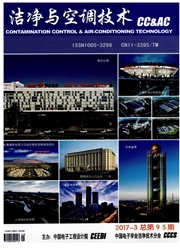

 中文摘要:
中文摘要:
采用计算流体力学方法,针对室内人员日常活动及办公行为两种不同情况下产生的颗粒物在置换通风室内的分布进行模拟研究。分析了5种典型粒径的颗粒物在这两种不同污染源释放位置下的浓度分布。结果表明,若污染源高度靠近地面,则产生的颗粒物在人员呼吸区浓度较低,而人员活动时在较高位置产生的颗粒物因受到热浮力的作用,在呼吸面上的浓度较高;热浮升力对小粒子(dp〈5.0μm)的输运起支配作用,而大粒子将受重力作用而沉降至地面。因此,不同污染源位置产生的不同粒径颗粒物对室内空气品质影响不同。
 英文摘要:
英文摘要:
Particle concentration distributions generated by two different cases (human normal activities and human working activities) are simulated in a displacement ventilated room by using a computational fluid dynamics (CFD) program, respectively, and five typical sizes of particle are considered for both of the cases. The results show that the source located near the floor has little influence on the concentration levels in the breathing zone, while the particle generated by human working which mainly influenced by buoyancy can result in a high concentration on the breathing zone; Transport of fine particle (dp〈 5.0 μm) indoor is dominated by buoyancy force, and gravitational sedimentation is the primary reason for larger particle's settling. Thus, different heights of particle sources have different effect on indoor air quality controlling.
 同期刊论文项目
同期刊论文项目
 同项目期刊论文
同项目期刊论文
 Relative Levels of Indoor and Outdoor Particle Number Concentrations in a Residential Building in Xi
Relative Levels of Indoor and Outdoor Particle Number Concentrations in a Residential Building in Xi 期刊信息
期刊信息
